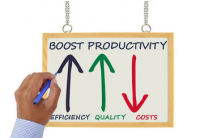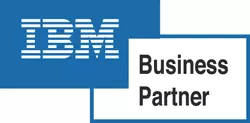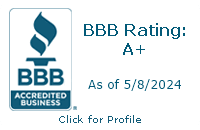
A current buzz phrase I've been hearing is "technology enablement." After doing some research and finding various interpretations of this, I'd define it as the strategic application of technology to improve business results and thereby increase business value. A few comments to elaborate:
- "Strategic application of technology" means applying technology consistent with the overall goals for technology usage, versus implementing multiple one-off point solutions. One part of such a strategy may be to only consider applications – whether on premise, in the cloud, or on a mobile device – having a robust set of web services to enable integrations with other applications.
- "Improve business results" refers to improving any part of the business, including sales, marketing, operations, new product development, management, and accounting.
- "Increase business value" means just that – increasing the business' value in the eyes of its owners or potential owners.
For example, shrinking the month-end closing process from 10 business days to 9 business days improves business results, yet likely not enough to increase business value, because 9 business days is still too long to close the books. Going from 10 business days to 5 business days, however, likely does increase business value, as everyone in accounting now has 5 extra days to work on forward-looking value-producing projects, instead of looking backwards for those 5 days.
I guess I'm a little jaded about "technology enablement" as a buzz phrase because Todd Herman Associates (THA) has, for over 31 years, helped our clients improve their business operations and profits by deploying technology and improving processes.
The Strategy Map – A Simplified Version
One of the best diagrams I've seen to show how improving technology and processes cascades through a business is the Strategy Map. Developed in the late 1990's by two consultants, Robert S. Kaplan and David P. Norton, the Strategy Map is a tool to help put business metrics – such as those in a Balanced Scorecard (a concept developed by the same two consultants and published in book form in 1996) – in context.
Here is my take on the Strategy Map:

Let me explain it from the bottom up:
- Resources are all the tangible and intangible assets available to the company.
- Processes are collections of tasks that "get things done." For example, the entire "Quote to Cash" cycle consists of several processes – Quoting, Receiving a Purchase Order, Creating a Sales Order, Fulfilling the Order, Invoicing the Products or Services, and Receiving and Recording Payments – that falls under "Customer Processes."
- Customer Benefits are the value the customer or client receives from the goods or services purchased.
- Company Goals are the various goals achieved by providing value to the customer or client, and by increasing productivity via internal process improvements.
- Financial Results are the outcome of all the preceding items and ultimately impact Business Value, achieved through sales growth, improved productivity, or both.
Here's the rub. Many people want to improve their company's financial results, yet fail to look at which levers they'll need to push and pull in order to achieve the desired Financial Results. Those levers? They are the 4 lowest areas in the simplified Strategy Map – Resources, Processes, Customer Benefits, and Company Goals. All 5 areas are interconnected, and you cannot make a change in one area without it rippling up or down the hierarchy shown.
Bringing this back around to "technology enablement." Processes have a dual nature – they consume resources and they produce results. Processes are also the mechanism linking People and Technology – how People use Technology to perform Processes to "get things done."
Let me illustrate "technology enablement" in action by briefly explaining 3 client projects, and show the levers they pulled to increase Business Value.
Requiring Sales Reps to Hold Margin
Of all the profit improvement techniques, holding margins is the easiest ... at least in concept. In practice, sales reps WANT to be liked by their customers, so they can frequently be a little too willing to deviate from company margin guidelines and "cut a deal" for a particular customer.
How to stop this?
- The Carrot Approach – Point out to sales reps that by holding margin, their compensation will increase because commissions are calculated and paid based on actual margins, not quoted margins.
- The Stick Approach – Require sales reps to use an application we designed and developed to prepare quotes for customers – and only allow quotes to be sent if they fall in the company-approved range of margins for a particular customer class.
Of course, human nature being what it is, the Carrot Approach was tried and produced some results for a while before returning to the previous low-margin results, while the Stick Approach quickly produced solid target-margin results and sustained those improved results ever since.

How this worked: This client provides kitchen installation and remodeling services, featuring cabinets developed by a sister company.
- New Technology – a Quoting Application developed by the client and us – took the CAD file developed by the designer and imported the various items in the design drawing as line items in a quote, which could then be easily priced based on prices already on file.
- The Quoting Application made the Quoting Process easier and quicker for client staff, and delivered two things the Customers very much appreciated – Quicker Turnaround and an All-In-One Quote on a project that would otherwise require multiple visits to other stores for products and services besides the cabinetry. Satisfied customers help our client secure more new customers and thus Grow Revenue.
- This application also enabled the Quoting Process – part of the Customer process group – to enforce margin requirements based on company criteria for a particular class of customer. Even if the sales rep wanted to discount price, the Quoting Application held price and enforced margin requirements, leading to Increased Margins.
Enabling a Business Pivot
Sometimes, a company's systems have been customized so much they can no longer be updated with bug fixes and new features. And sometimes, a company's business strategy includes a new, very different line of business their system cannot handle, even if all updates and fixes could be applied.
 That's what's happened to a client of ours – their strategy calls for explosive growth driven by a new custom-products division, along with continued organic growth of its traditional distribution business.
That's what's happened to a client of ours – their strategy calls for explosive growth driven by a new custom-products division, along with continued organic growth of its traditional distribution business.
To support the new division, strong light manufacturing capabilities are needed, something the current business system does not provide. Thus, we worked with them to map out their "current state" business processes, help envision the "future state" of these, identify business systems that could satisfy their needs, and work with them to select a new system.
How this worked: This client distributes packaging and other products to companies having warehouse and distribution operations.
- New Technology will enable all the nitty gritty tasks – storing information on materials and tasks required for production, ordering materials, scheduling production jobs, issuing materials to jobs, tracking labor, and recording production – that have to be orchestrated to make products via either In-House Production or Outsourced Production.
- These tasks are part of the Operations process group, working to deliver specific functionality in a Custom Product valued by a Customer, allowing our client to grow with their customer by Enhancing Customer Value.
Improving Accounting Department Productivity
What happens when technology usage in a company has "evolved" instead of having been "planned"? A patchwork of individual applications lacking integration.
Customers order a product or service through one of these applications, and are then directed to another application to pay for the order. When it comes time to ship the product or deliver the service, even more applications are involved.
Since these applications are not integrated, some accounting folks became "integrators" because they ...
- Learn about the payment when the credit card proceeds hit the bank account
- Research clues in the other systems to match the payment with the order
- Mark the order as having been paid
- Create an invoice in the accounting system
- Post the credit card payment against the invoice
Basically, these accounting personnel come in every day and spend virtually all their time "integrating" the disjointed applications. They are spending most of the day looking back – creating transactions to record what has already taken place – rather than working on forward-looking projects, such as a dashboard desired by the Board.

How this worked: This client provides a unique service to a very specialized industry.
- We do expect to find several process improvements to free up some time in the accounting area in the short term.
- Realistically, the bigger value will come from productivity gains associated with getting off the disjointed applications and onto a single new application that can handle taking an order, paying for the order, and fulfilling the order.
- To ensure these gains are achieved, we will work with our client to make sure the new application has the technologies needed to allow all these transactions to be automatically integrated with their accounting software, and then assist in making sure the Integrations work as intended.
- Our client's Customers will experience Faster Reporting and Recording and see Fewer Errors, leading to increased customer satisfaction, allowing our client to both Enhance Customer Value and Position for Growth as their industry grows.
- Automated integrations will require much less staff time than currently required, Cutting Non-Value Added Costs and improving productivity.
"Technology Enablement"
To recap the "technology enablement" in these 3 thumbnail project descriptions:
- System design and development of a quoting system to improve sales rep productivity and company profitability.
- Business process review and system selection of a new business system to enable strategic growth plans.
- Incremental process improvement as a stopgap measure, and business process re-engineering through system replacement and transaction integration as a "big bang" improvement.
In each of these cases, both our client and their customers benefit from "technology enablement."
- Our client increases its business value because of higher profits and higher return on net assets (RONA) resulting from various process and technology improvements.
- Our clients' customers experience increased value in the products or services they purchase and receive, coming from our client's process and technology improvements.
The moral of the story on "technology enablement"? Applying technology strategically to improve business results and thereby increase business value benefits both the company applying the technology and that company's customers.
Might "technology enablement" help your company achieve results like these? Perhaps – let's talk and explore this together.
Sincerely,
![]()
Todd L. Herman






